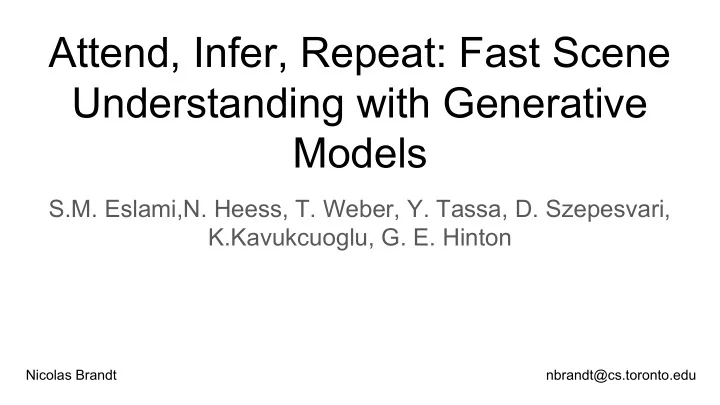

Attend, Infer, Repeat: Fast Scene Understanding with Generative Models S.M. Eslami,N. Heess, T. Weber, Y. Tassa, D. Szepesvari, K.Kavukcuoglu, G. E. Hinton Nicolas Brandt nbrandt@cs.toronto.edu
Origins Structured generative methods : Deep generative methods : + : More easily interpretable + : Impressive samples and likelihood score - : Inference hard and slow - : Lack of interpretable meaning How can we combine deep networks and structured probabilistic models in order to obtain interpretable data while being time efficient ? 2
Principle Many real-world scenes can be decomposed into objects. Thus, given an image x , we can make the modeling assumption that the underlying scene description z is structured into groups of variable z i . Each z i will represent the attributes of one object in the scene (type, appearance, position...) 3
Principle Given x and a model p θ ( x | z )p θ ( z ) parameterized by θ, we wish to recover z by computing p θ ( z | x ) = p θ ( x | z )p θ ( z )/p θ ( x ). p θ ( x ) = [1] As the number of objects present in the image will most likely vary from a picture to another, p N (n) will be our prior on the number of objects. NB: We have to define N which will be the maximum possible number of objects present in an image. 4
Principle The inference network will attend to one object at a time and train it jointly with its model. 5
Inference Network Most of the time, the equation [1] is intractable Necessity to approximate the true posterior. Learning a distribution q Φ ( z ,n| x ) parametrized by Φ that minimizes KL[q Φ ( z ,n| x )||p θ ( z ,n| x )] (amortized variational approximation ~ VAE) Nevertheless, in order to use this approximation we have to resolve 2 others problems. 6
Inference Network Trans-dimensionality: Amortized variational approximation is normally used with a fixed size of the latent space, here it is a random variable. We have to evaluate p N (n| x )= ∫p θ ( z ,n| x )d z for n=1,...,N Symmetry: As the index for each object is arbitrary, we can see alternative assignments of objects appearing in an image x to latent variable z i . In order to resolve these issues, we will use an iterative process implemented as a recurrent neural network. This network is run for N steps and will infer at each step the attributes of one object given the image and its previous knowledge of other objects on the image. 7
Inference Network If we consider a vector z pres composed of n ones followed by a zero we can consider q Φ ( z , z pres | x ) instead of q Φ ( z ,n| x ). This new representation will simplify the sequential reasoning : z pres can be considered as a counter stop. While the neural network q Φ outputs z pres =1, it means that the networks should describe at least one more object, if z pres =0, all objects have been described. 8
Learning process The parameters θ (model) and Φ (inference network) can be jointly optimized by using gradient descent in order to maximize : (negative free energy) If p θ is differentiable in θ, it is possible to compute a Monte Carlo Estimate of . Computing is a bit more complex. 9
Learning process For a step i, we consider w i =(z i pres , z i ). Thus, by using chain rule, we have : . Now, if we consider an arbitrary element z i from (z i pres , z i ), we will be able to compute the result with different methods depending on whether z i is continuous (position) or discrete (z i prez ). Continuous: we use the ‘re-parametrization trick’ in order to ‘back-propagate’ through z i Discrete: we use the likelihood ratio estimator. 10
Experiment: MNIST digits Objective: Learn to detect and generate the constituents digits from scratch. In this experiment, we will consider N=3. In practice, each image will only contain 0,1 or 2 numbers. Here, z i =(z i what ,z i where ) where z i what is an integer (value of the digit) and z i where is a 3-dimensional vector (scale and position of the digit) 11
Experiment: MNIST digits Generative Model: 12
Experiment: MNIST digits Inference Network: 13
Experiment: MNIST digits Interaction between Inference and Generation networks: 14
Experiment: MNIST digits Result: source : https://www.youtube.com/watch?v=4tc84kKdpY4&feature=youtu.be&t=60 15
Generalization When the model is trained only using images composed of 0, 1 or 2 digits, it will not be able to infer the correct count when given an image with 3 digits. The model learnt during the training to not expect more than 2 digits How can we improve the generalization ? 16
Differential AIR 17
Conclusion This model structure managed to keep interpretable representation while allowing fast inference (5.6 ms for MNIST). Nevertheless, there are still some challenges : ● Dealing with the reconstruction loss ● Not limiting the maximum number of objects 18
Thank you for your attention ! 19
Recommend
More recommend